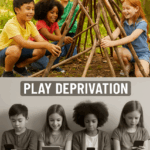10 Red Flags That Demand Attention
*(Based on DSM-5-TR behavioral addiction criteria & WHO guidelines)*
- Withdrawal Meltdowns
Extreme anger, crying, or violence when screens are removed—even for meals/baths. - Escalating “Screen Hunger”
Needing more time for the same satisfaction (e.g., demanding 3 hours instead of 1). - Loss of Real-World Joy
Abandoning hobbies, friends, or play that once excited them. - Secretive Use
Hiding devices, sneaking screen time, or lying about usage. - Physical Strain
Frequent headaches, eye rubbing, stiff neck, or disrupted sleep. - Dopamine-Driven Focus
*Can binge-watch for hours but struggles with 10 minutes of homework/reading.* - Social Withdrawal
Choosing screens over playdates, ignoring family, or avoiding eye contact. - Emotional Numbness
Flat affect offline but hyper-reactive to screen stimuli (e.g., laughing only at videos). - Academic/Developmental Slide
Declining grades, shortened attention span, or delayed speech/motor skills. - Preoccupation
Constantly talking about games/videos when offline.
Critical Insight: *3+ signs persisting over 3 months signal clinical concern.*
Why Young Brains Are Vulnerable
Screen addiction isn’t a “phase”—it rewires developing brains:
- Dopamine Surges: Fast-paced content creates drug-like neurological cravings.
- Rewired Reward Circuits: Real-world play feels “boring” by comparison.
- Stunted Frontal Lobes: Impulse control and empathy networks weaken.
A 2024 Study Reveals:
Children under 6 with >2 hours daily screen time show 4x higher addiction risk than teens (Journal of Child Psychology).
Your Action Plan: 4 Steps to Reset
✅ Step 1: Track Triggers
Use our free <u>Digital Behavior Journal</u> to log:
- When cravings peak (boredom? stress?)
- Emotional states before/during use
✅ Step 2: Tech-Free Zones/Times
Non-negotiable sanctuaries:
- Bedrooms (charge devices in kitchen)
- Mealtimes (model device-free focus)
✅ Step 3: “Connection Before Correction”
Before removing screens:
- “Show me what you’re building!” (validate interests)
- “Let’s pause after this level together” (co-regulate)
✅ Step 4: Fill the Void with Joy
Replace screen dopamine with:
- Sensory play: Kinetic sand, water tables
- Movement: Obstacle courses, dance parties
- Social rewards: Cooking together, family board games
When to Seek Professional Help
WellChild Haven’s Digital Wellness Consultants intervene if your child shows:
- Physical aggression when screens are removed
- School refusal or social isolation
- Developmental regression (e.g., bedwetting, baby talk)
Our Evidence-Based Approach:
- Addiction Severity Assessment (validated screening tools)
- Brain-Balancing Strategies:
- Dopamine detox plans
- Sensory integration therapy
- Family Reconnection Toolkit:
- Screen-time contracts
- “Connection rituals” to replace digital pacifiers
“After our son bit his sister during a tablet removal, we panicked. In 6 weeks, WellChild Haven helped us cut screen time by 80%—using play therapy, not punishment.”
— Priya M., mother of 5-year-old
Take Control Today
Free Resource:
???? [Download: “Is My Child Addicted?” Checklist]
(Includes severity scale & immediate steps)
Professional Support:
???? [Book a Digital Wellness Consultation]
$120 | Covered by select insurance plans
Urgent Crisis?
☎️ Call our Screen Addiction Hotline: (555) 123-HELP
*(24/7 support for extreme behaviors)*



